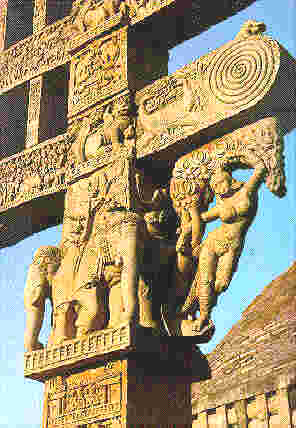|
Dear Visitor,
I welcome you to this non-profit, educational page. Here you
will read about different aspects of the history and culture of
that part of our globe which is known variously as Bharatvarsha,
Hindostan or India. My approach of looking at history is that of
a rationalist
and humanist.
As my aim is to spread awareness about history and culture, you
may freely download this page, print it, link it up from your
site, or mirror it at any server. Enjoy the infotainment laid
out for you at this site. I also look forward to your valuable
suggestions and feedback. Happy viewing.
Author
Hindu History
India's Raj-Namavali (Political Chronology)
- The List of Kings who Shaped India's Destiny (from 250 B.C.E. up to the Muslim Aggression circa 1194 C.E.)
By Shri Sudheer Birodkar
 The Post-Maurya Dynasties at Pataliputra - The Shungas and the Kanvas
The Post-Maurya Dynasties at Pataliputra - The Shungas and the Kanvas
The period from the fall of the Maurya empire in the 2nd century
B.C.E. upto rise of the Guptas in the 3rd century C.E. saw a string of
smaller dynasties rule from Patliputra. The Maurya Empire itself had
started shrinking after the passing away of Samrat Ashoka Maurya. The
last Maurya Emperor was Brihadratha, the grandson of Samrat Ashoka.
Brihadratha was assasinated by his general Pushyamitra Shunga who
started the Shunga dynasty. This dynasty ruled for a few decades and was
displaced by another dynasty, that of the Kanvas. But neither dynasty
could recreate the splendour of the Mauryas. Meanwhile in the north-west
of the country a procession of invaders came into India.
The first were the Kushanas (Ku-Shan) who were a sub-set of the Yuei-Chi from today's Sinkiang area of Eastern China. They came as invaders but settled down in India and were absorbed into Indian society. The most illustrious ruler of this line was Emperor Kanishka embraced Buddhism and patronised it. He ordered the scuplting of the massive (150 feet high) monolithic images of Buddha at Bamiyan in Afghanistan. He also gave generous grants for the construction of Stupas, Chaityas and Viharas. The Stupa at Sanchi (seen alongside) is typical of the many Stupas, Chaityas and Viharas that dotted the Indian countryside in Maurya and Post-Maurya times (circa 2nd century B.C.E. up to the 12th century C.E.). These Stupas, along with the many Hindu and Jain temples, apart from being centers of learning and religious activity, also served as revenue collection centers. For this reason, they were supported by feudal lords with generous grants like the Brahmadeya, Devdana and Agrahara.
The Post-Maurya Dynasties at Pataliputra - The Shungas and the Kanvas.
The period from the fall of the Maurya empire in the 2nd century B.C.E. upto rise of the Guptas in the 3rd century C.E. saw a string of smaller dynasties rule from Patliputra. The Maurya Empire itself had started shrinking after the passing away of Samrat Ashoka Maurya. The last Maurya Emperor was Brihadratha, the grandson of Samrat Ashoka. Brihadratha was assasinated by his general
Pushyamitra Shunga who started the Shunga dynasty. This dynasty ruled for a few decades and was displaced by another dynasty, that of the Kanvas. But neither
dynasty could recreate the splendour of the Mauryas.
Meanwhile in the north-west of the country a procession of invaders came into
India.
Author: Shri Sudheer Birodkar
|